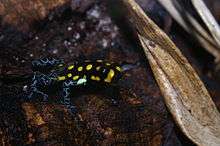Ranitomeya vanzolinii
| Ranitomeya vanzolinii | |
|---|---|
 | |
| Scientific classification | |
| Kingdom: | Animalia |
| Phylum: | Chordata |
| Class: | Amphibia |
| Order: | Anura |
| Family: | Dendrobatidae |
| Genus: | Ranitomeya |
| Species: | R. vanzolinii |
| Binomial name | |
| Ranitomeya vanzolinii (Myers, 1982) | |
| Synonyms | |
|
Dendrobates vanzolinii Myers, 1982 | |
Ranitomeya vanzolinii, also known as the Brazilian poison frog[2] or spotted poison frog,[3] is a species of frog from the family Dendrobatidae. It is found in the Amazonian rainforests of Brazil and Peru, and possibly Bolivia.[2]
Etymology
The specific name vanzolinii honors Paulo Vanzolini, a Brazilian herpetologist and composer.[4]
Description
Adults of this species grow to between 16.7–19 mm (0.66–0.75 in) snout–vent length and feed on a variety of tiny invertebrates.[5] During the breeding season males have loud trill-like call.[6] Unlike many species of dendrobatids the parents of Ranitomeya vanzolinii offspring return to feed their young. They will lay their fertile egg in an isolated pool. A bromeliad which has filled with water is an ideal place. Once the tadpole hatches the female encouraged by the male will lay an infertile egg into the small pool, this provides the tadpole with a food source until it can fend for itself. The parents form a stable pair during this period.[3][6]
Habitat and conservation
The species' natural habitats are pre-montane cloud forests and lowland rainforests.[1] Adults are primarily arboreal, mostly found up to 2 metres above ground, occasionally higher.[5]
Populations have probably declined in recent years. It is locally threatened by habitat loss and illegal pet trade.[1]
References
- 1 2 3 IUCN SSC Amphibian Specialist Group (2014). "Ranitomeya vanzolinii". The IUCN Red List of Threatened Species. IUCN. 2014: e.T55206A43734521. doi:10.2305/IUCN.UK.2014-1.RLTS.T55206A43734521.en. Retrieved 10 January 2018.
- 1 2 Frost, Darrel R. (2015). "Ranitomeya vanzolinii (Myers, 1982)". Amphibian Species of the World: an Online Reference. Version 6.0. American Museum of Natural History. Retrieved 24 April 2015.
- 1 2 Caldwell, JP (1997). "Pair bonding in spotted poison frogs". Nature. 385: 211. doi:10.1038/385211a0.
- ↑ Beolens, Bo; Watkins, Michael; Grayson, Michael (2013). The Eponym Dictionary of Amphibians. Exeter, England: Pelagic Publishing. pp. 346–347. ISBN 978-1-907807-44-2.
- 1 2 "Ranitomeya vanzolinii". AmphibiaWeb: Information on amphibian biology and conservation. [web application]. Berkeley, California: AmphibiaWeb. 2015. Retrieved 24 April 2015.
- 1 2 Brown JL, Twomey E, Amézquita A, de Souza MB, Caldwell JP, Lötters S, von May R, Melo-Sampaio PR, Mejía-Vargas D, Pérez-Peña PE, Pepper M, Poelman EH, Sanchez-Rodriguez M, Summers K (2011). "A taxonomic revision of the Neotropical frog genus Ranitomeya (Amphibia: Dendrobatidae)" (PDF). Zootaxa. 3083: 1–120.
